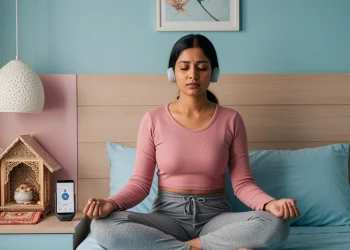Sleep isn’t just a single state of unconsciousness – it’s a complex, beautifully orchestrated symphony of different stages, each playing a crucial role in your physical and mental well-being. Understanding the intricate dance between REM sleep and deep sleep stage cycles can transform not just how you rest, but how you live, work, and thrive.
If you’ve ever wondered why some nights leave you feeling completely refreshed while others leave you groggy despite getting eight hours of sleep, the answer lies in the quality and optimization of your sleep stages. Modern sleep science reveals that it’s not just about duration – it’s about maximizing each phase of your sleep architecture for optimal health outcomes.
Understanding the Functions of Each Sleep Stage
Your nightly sleep journey consists of multiple cycles, each lasting approximately 90 minutes and containing distinct stages with unique biological functions. Think of sleep as a carefully choreographed restoration process where your body and mind undergo specific maintenance tasks during each phase.
Light sleep serves as the gentle transition between wakefulness and deeper sleep states. During this stage, your heart rate and breathing begin to slow, your muscles start to relax, and your brain waves shift from the active beta waves of wakefulness to the slower alpha and theta waves. This stage typically accounts for about 50-60% of your total sleep time and acts as the gateway to more restorative phases. While light sleep might seem less important than its deeper counterparts, it plays a crucial role in processing the day’s experiences and preparing your brain for the intensive work that happens in subsequent stages.
Deep sleep stage, also known as slow-wave sleep or Stage 3 NREM (Non-Rapid Eye Movement) sleep, represents the most physically restorative period of your sleep cycle. During this phase, your brain waves slow dramatically to delta waves, your heart rate and blood pressure drop to their lowest points, and your body temperature slightly decreases. This is when your body releases growth hormone, repairs tissues, builds muscle, strengthens your immune system, and consolidates procedural memories – the kind that help you remember how to ride a bike or type on a keyboard.
The deep sleep stage is particularly crucial for physical recovery and immune function. Research shows that during this phase, your brain’s glymphatic system becomes highly active, essentially washing away metabolic waste products, including beta-amyloid proteins associated with Alzheimer’s disease. Your body also increases production of white blood cells, strengthening your immune response and helping you fight off infections more effectively.
REM sleep (Rapid Eye Movement sleep) serves an entirely different but equally vital function. During this stage, your brain becomes almost as active as when you’re awake, but your body becomes temporarily paralyzed to prevent you from acting out your dreams. REM sleep is primarily responsible for emotional regulation, creative problem-solving, and memory consolidation – particularly for declarative memories like facts, events, and learning new skills.
During REM sleep, your brain processes emotional experiences from the day, helping you maintain psychological balance and emotional resilience. This stage is also when most vivid dreaming occurs, and these dreams play a crucial role in creative thinking and problem-solving. Studies have shown that people who get adequate REM sleep perform better on creative tasks and are more likely to find innovative solutions to complex problems.
The proportion of time spent in each stage changes throughout the night. Deep sleep dominates the first half of your sleep period, typically occurring in longer periods during the first two sleep cycles. REM sleep, conversely, becomes more prominent in the latter half of the night, with REM periods becoming longer and more frequent toward morning. This natural pattern explains why waking up too early can leave you feeling emotionally unbalanced or cognitively foggy – you may have missed crucial REM sleep time.
Indian Dietary Factors Affecting REM Sleep
Traditional Indian cuisine offers a treasure trove of natural compounds that can significantly influence your sleep architecture, particularly REM sleep quality. Understanding how specific foods and eating patterns affect your sleep stages can help you optimize your diet for better rest.
Tryptophan-rich foods form the foundation of REM sleep enhancement through dietary choices. Milk, which holds a revered place in Indian culture, contains high levels of tryptophan – an amino acid that serves as a precursor to serotonin and subsequently melatonin. The traditional practice of drinking warm milk before bed isn’t just cultural wisdom; it’s biochemically sound. The warmth helps release tryptophan more effectively, while the ritual itself signals to your brain that it’s time to wind down.
Almonds and walnuts, commonly consumed in Indian households, provide not only tryptophan but also magnesium and healthy fats that support neurotransmitter production. Soaking almonds overnight, a common Indian practice, may actually increase their bioavailability. These nuts also contain natural melatonin, which helps regulate your circadian rhythm and promote quality REM sleep.
Spices and herbs integral to Indian cooking possess remarkable sleep-enhancing properties. Turmeric, with its active compound curcumin, has anti-inflammatory properties that can improve overall sleep quality. Consuming turmeric in warm milk (haldi doodh) combines multiple sleep-promoting compounds in one traditional remedy. Ashwagandha, an adaptogenic herb used in Ayurveda for centuries, has been scientifically proven to reduce cortisol levels and improve sleep quality, particularly benefiting REM sleep duration.
However, certain aspects of Indian dietary patterns can negatively impact REM sleep when poorly timed. Heavy, spicy meals close to bedtime can disrupt sleep architecture by raising your core body temperature and stimulating your digestive system. The capsaicin in chili peppers, while beneficial for metabolism during the day, can interfere with sleep onset and reduce REM sleep quality when consumed late in the evening.
Timing your carbohydrate intake strategically can enhance REM sleep. Complex carbohydrates from traditional sources like brown rice, quinoa, or bajra consumed 3-4 hours before bed can promote serotonin production without causing blood sugar spikes that might wake you during the night. The practice of eating lighter dinners, common in many Indian households, aligns perfectly with optimal sleep hygiene.
Traditional fermented foods like idli, dosa, and kefir contain probiotics that support gut health, which emerging research links to improved sleep quality through the gut-brain axis. A healthy gut microbiome appears to influence neurotransmitter production, including those crucial for REM sleep regulation.
Exercise Timing for Deep Sleep Enhancement
The relationship between physical activity and sleep stages is nuanced, with timing playing a crucial role in determining whether exercise enhances or disrupts your deep sleep stage. Understanding when and how to exercise can dramatically improve your sleep architecture and overall recovery.
Morning and afternoon exercise provides the most beneficial impact on deep sleep quality. When you engage in moderate to vigorous physical activity earlier in the day, you create several physiological conditions that promote deeper sleep later. Exercise increases your core body temperature during activity, and the subsequent cooling period that occurs hours later signals to your brain that it’s time for sleep. This temperature drop is particularly important for initiating and maintaining deep sleep stages.
Cardiovascular exercise performed in the morning or early afternoon has been shown to increase the amount of time spent in deep sleep by 13-17% in research studies. Activities like brisk walking, jogging, cycling, or swimming trigger the release of growth hormone and create the physical fatigue that your body seeks to repair during deep sleep. The key is allowing at least 4-6 hours between vigorous exercise and bedtime to avoid the alerting effects of exercise-induced adrenaline and endorphins.
Strength training offers unique benefits for deep sleep enhancement through different mechanisms. Resistance exercise creates microscopic muscle damage that your body repairs primarily during deep sleep stages. This natural process increases your body’s drive for deep sleep, leading to longer and more restorative deep sleep periods. However, intense strength training should be completed at least 3-4 hours before bed to allow your nervous system to calm down.
Yoga and gentle stretching in the evening can actually promote better sleep architecture when practiced mindfully. These activities help activate your parasympathetic nervous system, reduce cortisol levels, and prepare your body for rest. Traditional yoga practices like gentle flows, restorative poses, and pranayama (breathing exercises) can improve both sleep onset and deep sleep quality when performed 1-2 hours before bed.
The timing of exercise becomes even more critical for shift workers or those with irregular schedules. If you must exercise close to bedtime due to scheduling constraints, focus on low-intensity activities and incorporate cooling strategies like a cool shower afterward to help your body temperature return to baseline more quickly.
Consistency in exercise timing appears to be as important as the exercise itself. Your circadian rhythm adapts to regular exercise patterns, optimizing hormone release and body temperature fluctuations to enhance sleep quality. People who exercise at the same time daily often experience more predictable and deeper sleep patterns.
Age-Related Sleep Stage Changes
Sleep architecture undergoes significant transformations throughout your lifespan, with each decade bringing distinct changes in the proportion and quality of different sleep stages. Understanding these natural progressions can help you adjust your sleep optimization strategies accordingly.
Childhood and adolescence represent periods of maximum deep sleep, which makes biological sense given the rapid growth and development occurring during these years. Children typically spend 20-25% of their sleep time in deep sleep stages, compared to just 10-15% in healthy older adults. During adolescence, circadian rhythms naturally shift toward later bedtimes and wake times, a phenomenon called delayed sleep phase. This biological shift often conflicts with early school schedules, leading to chronic sleep deprivation that can impact both deep sleep and REM sleep quality.
Young adulthood (20s and 30s) generally represents optimal sleep architecture for most people. Deep sleep remains robust, REM sleep is well-organized, and the ability to recover from occasional sleep disruption is at its peak. However, this is also when many people begin to experience sleep challenges related to career stress, relationship changes, and lifestyle factors that can impact sleep quality.
Middle age (40s and 50s) brings the first noticeable decline in deep sleep stage duration and intensity. Deep sleep decreases by approximately 2% per decade after age 40, while sleep becomes more fragmented with increased awakenings. This reduction in deep sleep can impact physical recovery, immune function, and cognitive performance. Hormonal changes, particularly the decline in growth hormone production, contribute to these changes in sleep architecture.
For women, perimenopause and menopause create additional sleep challenges through hormonal fluctuations. Declining estrogen and progesterone levels can reduce REM sleep quality and increase sleep disruptions. Hot flashes and night sweats, common during this transition, can fragment sleep and reduce time spent in deeper sleep stages.
Later adulthood (60+) is characterized by earlier bedtimes, earlier wake times, and significant changes in sleep stage distribution. Older adults often experience a reduction in both deep sleep and REM sleep, with increased time spent in lighter sleep stages. This can lead to less restorative sleep despite adequate sleep duration. However, research shows that many age-related sleep changes can be mitigated through proper sleep hygiene, regular exercise, and targeted interventions.
The cumulative effects of reduced deep sleep over time can impact cognitive function, immune response, and physical health. However, understanding these natural changes allows for proactive adjustments to sleep optimization strategies throughout your lifespan.
Supplements and Herbs for Stage Optimization
Natural supplements and traditional herbs offer powerful tools for enhancing specific sleep stages, with many options deeply rooted in both scientific research and traditional medicine systems like Ayurveda.
Magnesium stands out as one of the most effective minerals for improving deep sleep quality. This essential mineral acts as a natural muscle relaxant and nervous system calmer, helping your body transition into deeper sleep stages more easily. Magnesium glycinate, in particular, has high bioavailability and is less likely to cause digestive upset. A dose of 200-400mg taken 1-2 hours before bed can significantly improve deep sleep duration and quality.
Ashwagandha, a cornerstone of Ayurvedic medicine, offers remarkable benefits for both stress reduction and sleep optimization. Clinical studies show that standardized ashwagandha extract (typically 300-500mg) can reduce cortisol levels by up to 30% and improve sleep quality scores significantly. Its adaptogenic properties help regulate your stress response system, promoting better sleep architecture overall.
L-theanine, an amino acid found in tea leaves, promotes relaxation without sedation and can improve REM sleep quality. Unlike many sleep aids that can suppress REM sleep, L-theanine appears to enhance this crucial stage while reducing the time it takes to fall asleep. A dose of 100-200mg taken 30 minutes before bed works synergistically with magnesium for optimal results.
Melatonin should be used strategically rather than as a nightly sleep aid. Small doses (0.5-1mg) taken 2-3 hours before your desired bedtime can help regulate circadian rhythms and improve sleep architecture, particularly in people with shift work or jet lag. Higher doses often used commercially (3-10mg) can actually disrupt natural melatonin production and sleep cycles.
Traditional Ayurvedic herbs like Brahmi (Bacopa monnieri) and Jatamansi have been used for centuries to promote restful sleep and mental clarity. Modern research supports their use for improving sleep quality and reducing anxiety that can interfere with deep sleep stages. These herbs work best when used consistently over time rather than as acute interventions.
Valerian root has extensive research supporting its use for improving sleep onset and deep sleep quality. However, it can take 2-4 weeks of consistent use to achieve optimal benefits, and some people may experience vivid dreams or morning grogginess initially.
It’s crucial to approach supplements systematically, starting with one at a time to assess individual responses and potential interactions. Quality matters significantly with herbal supplements, so choosing standardized extracts from reputable sources ensures consistency and potency.
Tracking and Improving Sleep Architecture
Modern technology offers unprecedented insights into your personal sleep architecture, enabling data-driven optimization of your sleep stages for better health outcomes. Understanding how to effectively track and interpret your sleep data can transform your approach to rest and recovery.
Wearable sleep tracking devices have evolved significantly in accuracy and usefulness. Modern devices use a combination of heart rate variability, movement sensors, and skin temperature to estimate sleep stages with reasonable accuracy compared to clinical sleep studies. While not perfect, these devices provide valuable trends and patterns that can guide your sleep optimization efforts.
When analyzing your sleep data, focus on consistent patterns rather than single nights. Look for trends in deep sleep percentage (ideally 15-20% of total sleep), REM sleep duration (typically 20-25% of total sleep), and sleep efficiency (time asleep divided by time in bed, ideally above 85%). Pay attention to how different factors like exercise timing, diet, stress levels, and sleep environment affect these metrics.
Sleep stage optimization requires a systematic approach. Start by establishing a consistent sleep schedule that aligns with your natural circadian rhythm. Most people have genetic tendencies toward earlier or later sleep preferences, and working with rather than against these tendencies improves sleep architecture significantly.
Environmental factors play a crucial role in sleep stage quality. Temperature regulation is particularly important for deep sleep, with cooler temperatures (65-68°F or 18-20°C) promoting better deep sleep stages. Use breathable bedding materials and consider a cooling mattress or pillow if you tend to sleep warm.
Light exposure patterns significantly impact your circadian rhythm and subsequent sleep architecture. Expose yourself to bright light, preferably sunlight, within the first hour of waking to reinforce your natural sleep-wake cycle. Conversely, dim lights and avoid blue light from electronic devices 2-3 hours before bedtime to promote natural melatonin production.
Developing a consistent pre-sleep routine signals to your brain that it’s time to begin the transition to sleep. This routine should last 30-60 minutes and include relaxing activities like reading, gentle stretching, meditation, or warm baths. The key is consistency – performing the same sequence of activities each night trains your brain to anticipate sleep.
Stress management is crucial for protecting both REM and deep sleep stages. Chronic stress elevates cortisol levels, which can suppress growth hormone release and fragment sleep architecture. Incorporate stress-reduction techniques like mindfulness meditation, journaling, or breathing exercises into your daily routine, particularly in the evening hours.
Conclusion: Your Journey to Optimal Sleep Architecture
Understanding and optimizing your sleep stages isn’t just about feeling more rested – it’s about unlocking your body’s natural ability to heal, learn, and thrive. The intricate balance between REM sleep, deep sleep stage, and light sleep creates the foundation for physical health, emotional resilience, and cognitive performance.
By implementing the strategies outlined in this guide – from mindful dietary choices rooted in traditional wisdom to strategic exercise timing and natural supplementation – you can begin to transform your sleep architecture tonight. Remember that sleep optimization is a journey, not a destination. Small, consistent changes compound over time to create dramatic improvements in how you look, feel, and perform.
Start by choosing one or two strategies that resonate most with your current lifestyle and gradually build upon your success. Whether it’s incorporating traditional Indian herbs into your evening routine, adjusting your exercise timing, or creating a technology-supported sleep tracking system, every step toward better sleep architecture is a step toward optimal health.
Ready to transform your sleep and unlock your fullest potential? Explore our comprehensive collection of sleep optimization solutions, from traditional herbal supplements to cutting-edge sleep tracking tools, designed to help you master every stage of your sleep journey.







